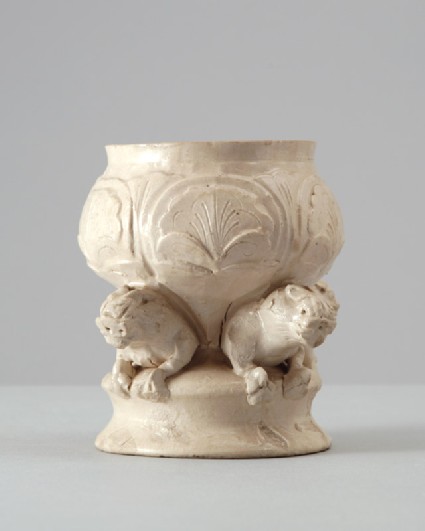The Barlow Collection
A select catalogue of the Barlow collection of Chinese Ceramics, Bronzes and Jades by the University of Sussex (published Sussex, 2006).

Publications online: 456 objects
Cizhou type incense burner with four lions
- loan
-
Literature notes
The globular bowl has five-lobed sides and a straight (cut-down) rim. It is carved in high relief with frilly flower petals with incised details, the indents are clearly visible on the inside. It is supported on a tall, hollow stem, from which four lions appear to emerge, their front paws resting on a wide waisted plinth. The animals are roughly formed by hand, with ears and paws separately attached and details incised and pricked. The off-white stoneware bears a white slip and a transparent glaze with a greenish tinge. Spiralling grooves from shaping can be seen inside the bowl. The footring remained unglazed and is rough, with grit adhering from the firing supports, and some patches on the foot were accidentally left without glaze. The piece is cut down and may originally have had an everted rim. -
Details
- Associated place
-
Asia › China › Cizhou kiln-sites (place of creation)
- Date
-
11th - 12th century (1001 - 1200)
Northern Song Dynasty (AD 960 - 1127)
- Material and technique
- stoneware, thrown, covered in white slip, and with carved, incised, and pierced decoration under a transparent glaze; lions hand-modelled or moulded and luted to the incense burner with slip; partly glazed base; glazed rim
- Dimensions
-
10.5 cm (height)
11.1 cm (diameter)
at base 8.1 cm (diameter)
- Material index
- Technique index
- Object type index
- No. of items
- 1
- Credit line
- Lent by the Sir Alan Barlow Collection Trust.
- Accession no.
- LI1301.367
-
Further reading
University of Sussex, and Arts and Humanities Research Council, The Barlow Collection, supervised by Regina Krahl, Maurice Howard, and Aiden Leeves (Sussex: University of Sussex, 2006), no. C367
Glossary (4)
glaze, luted, slip, stoneware
-
glaze
Vitreous coating applied to the surface of a ceramic to make it impermeable or for decorative effect.
-
luted
The fusion of parts of ceramics using dilute clay slip.
-
slip
A semi-fluid clay applied to a ceramic before glazing either to coat the surface or for decorative effect.
-
stoneware
Ceramic material made of clay which is fired to a temperature of c.1200-1300⁰c and is often buff or grey in colour.
Location
-
- currently in research collection
Objects are sometimes moved to a different location. Our object location data is usually updated on a monthly basis. Contact the Jameel Study Centre if you are planning to visit the museum to see a particular object on display, or would like to arrange an appointment to see an object in our reserve collections.
Publications online
-

The Barlow Collection
The globular bowl has five-lobed sides and a straight (cut-down) rim. It is carved in high relief with frilly flower petals with incised details, the indents are clearly visible on the inside. It is supported on a tall, hollow stem, from which four lions appear to emerge, their front paws resting on a wide waisted plinth. The animals are roughly formed by hand, with ears and paws separately attached and details incised and pricked. The off-white stoneware bears a white slip and a transparent glaze with a greenish tinge. Spiralling grooves from shaping can be seen inside the bowl. The footring remained unglazed and is rough, with grit adhering from the firing supports, and some patches on the foot were accidentally left without glaze. The piece is cut down and may originally have had an everted rim.
Notice
Object information may not accurately reflect the actual contents of the original publication, since our online objects contain current information held in our collections database. Click on 'buy this publication' to purchase printed versions of our online publications, where available, or contact the Jameel Study Centre to arrange access to books on our collections that are now out of print.
© 2013 University of Oxford - Ashmolean Museum




